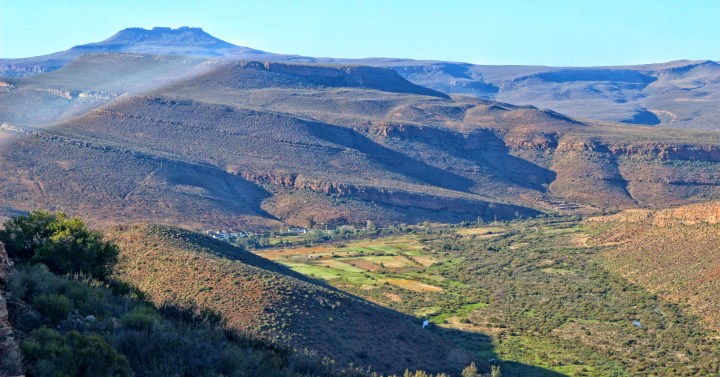ROOIBOS HERITAGE
Plant matter: How rooibos brought justice to SA’s indigenous

An industry-wide agreement under the UN’s Nagoya Protocol has just recognised the claim of five Khoisan groups to their heritage. This is more than any South African government has ever done. The agreement poses a set of tough questions not just to President Cyril Ramaphosa and the legislation that’s languishing on his desk, but to the government and its strategy for climate adaptation. And it’s all because of rooibos.
I.
“By recognising our knowledge, they are actually recognising our identity.”
For Oom Cecil Le Fleur, chairperson of the National Khoi & San Council, this was the crux of the matter. The smile on his face was half wry and half astonished, an expression of the irony that a medicinal plant — a tea — was about to do for his people what no government of South Africa ever had. That is, deliver on the Khoisan’s rightful claim to their heritage and to their land.
It was not a statement that Oom Cecil made lightly. As the great-grandson of Adam Kok III, the indigenous chief who had trekked across the Drakensberg to establish the independent state of Griqualand East in the early 1860s, the struggle for recognition was hardwired into his DNA. Seized by the British in 1874, Griqualand East was for him just another in a long litany of losses, a catalogue of dispossession that had rendered the Khoisan of South Africa — comprised of the Griqua, the Cape-Khoi, the Nama, the Korana and the San — the most oppressed indigenous collective in the world.
Oom Cecil, it soon became clear, had no time for hyperbole. The eradication of Khoisan tradition was directly connected in his mind to the fact that these five groupings had been hunted for sport, erased from the land like the elephants that once roamed the banks of the Olifants River. He wanted it known that in comparison to the indigenous tribes of the Amazon or central Australia, where there was still a measure of attachment to vast ancestral territories, South Africa’s original cultures had been all but wiped out.
The only exceptions, Oom Cecil said, were deep in the Kalahari and high in the Cederberg mountains — where people like Oom Barend Salomo lived.
The day before, Daily Maverick had met Oom Barend in Wupperthal. An impossibly beautiful village bisected by the Trata River and surrounded on all sides by steep sandstone cliffs, the point of focus was the Moravian Church. When the German missionaries arrived in the late 1820s, Oom Barend explained, they found seven Khoi families in the valley. Oom Barend’s great-great-grandfather, who was born in 1823, was a child at the time — and so the story had been passed down through the generations.
First, confronted with a community that had never considered the concept of land ownership before, the Germans registered the territory for themselves. Then, since it reminded them of the Wupper River back home, they gave it a new name. In the late 1830s, with the abolition of slavery, the population of Wupperthal exploded.
It was at this point, according to Oom Barend, that the Germans were introduced to the tea. The wife of the resident missionary was the village nurse, and she noticed that a small flowering shrub was being harvested by the Khoi to treat skin rashes, relieve stomach ailments and strengthen teeth and bones.
“We built this church ourselves,” said Oom Barend. “Our people would work for four months and then the missionaries would give us two months off to do wild harvesting in the mountains. We would sell the leaves from the plant back to them. And so this was the first trade in rooibos, it started here.”
Rooibos: the name that would go on to define a global industry. As late as October 2019, the tea’s purveyors were telling a different story to the one Daily Maverick heard from Oom Barend. For instance, on the website of Rooibos Limited (“preferred supplier since 1954”), visitors could read that “migrants and settlers in the Cederberg area discovered that the fine, needle-like leaves of the Aspalathus linearis plant make a tasty, aromatic tea.”

Rooibos (image supplied)
Even the South African Rooibos Council, whose members include wholesale giants like Unilever and National Brands, were reporting that “a Russian immigrant to South Africa, Benjamin Ginsberg, recognised the potential of this unique ‘mountain tea’ in 1904… becoming the first exporter.”
But Oom Barend supplied the name of Willie Strassberger, the missionary whose wife was the nurse. When Strassberger moved to Clanwilliam in 1845, he said, he opened a factory that not only used the processing methods of the Wupperthal Khoi but employed the people too.
“You know, the Wupperthal area is the epicentre of rooibos,” Oom Barend added, “because the highest population of wild rooibos you will find here.”
And yet nowhere in the history of the plant as told by the South African Rooibos Council was there mention of Strassberger or the town. As an indication that Oom Barend may have been telling the truth, the Strassbergers featured on the headstones in the old Wupperthal cemetery.
II.
There was, of course, more substantial proof that the oral history passed down to Oom Barend was correct — again, if someone like Oom Cecil from the National Khoi & San Council was excited, a man who had heard it all before, some serious back-up to the Khoisan version must have emerged.
That back-up, it turned out, was contained in the phrase “Nagoya Protocol”. A supplementary agreement to the UN’s Convention on Biological Diversity, the protocol was adopted in Japan in 2010, entering into force on 12 October 2014. Among its founding purposes was to ensure the “fair and equitable sharing of benefits arising out of the utilisation of genetic resources,” specifically where traditional knowledge was concerned. As the first global instrument of relevance to indigenous and local communities adopted since the ratification of the UN Declaration on the Rights of Indigenous Peoples, it was set up to mainstream those rights in international negotiations.
And the rooibos plant, from the Cederberg mountains in the Western Cape, was one of the protocol’s first major triumphs.
Never before, according to Lesle Jansen, an indigenous lawyer with the NGO Natural Justice who had been on the case from the start, had the Nagoya Protocol provided the framework for such a wide-ranging concern.
“What makes this unique,” she told Daily Maverick, “is that most of the benefit-sharing agreements across the world have been for what they call ‘material transfers’. Basically, purchasing the resources. There’s not been an agreement with a traditional knowledge levy, or a royalty.”
In other words, Jansen explained, the majority of contracts under the protocol had so far been about the raw materials only — until rooibos came along, the indigenous knowledge that had uncovered the properties of these resources had been contractually ignored.
“The other aspect that makes this unique is the fact that it’s an industry-wide agreement,” she added. “At the scale that we’re doing it, as far as we know, it has not been done before.”
So maybe Rooibos Limited and the members of the local Rooibos Council hadn’t gotten around to updating their websites; this hadn’t changed the fact that the agreement was signed and concluded on 25 May 2019, entitling the five groups under South Africa’s Khoisan umbrella to a 1.5% royalty on all purchases “at the farm gate”. Neither had it changed the fact that on 1 November 2019, environment, forestry and fisheries minister Barbara Creecy would officially launch the agreement at !Khwa ttu, a cultural tourism venue an hour north of Cape Town co-owned by the San.
How, exactly, had things arrived at this historical juncture? Inevitably perhaps, the genesis was in a dirty commercial secret.

Honeybush. (Photo: Gallo Images / Landbouweekblad / Lucille van Rooyen)
In 2010, after Nestlé’s research division had “innovated” a suite of cosmetic products from the properties of rooibos and honeybush, the conglomerate applied to the World Intellectual Property Organisation for a set of patents. The technical term for this was “biopiracy”: Nestlé had asked neither the South African government nor the plants’ knowledge holders for consent. A Swiss NGO got wind of it and brought in Natural Justice; the organisations then ran a campaign to block the applications, which succeeded.
Three years later, humbled, Nestlé politely asked for consent on a different rooibos product (an idea that would eventually be branded as Red Espresso). In 2014, negotiations began on a benefit-sharing agreement between the conglomerate, the South African San Council and the National Khoi & San Council. The government, intending to settle the question once and for all, commissioned a study to establish whether the San and Khoi were indeed the knowledge holders of rooibos — the study confirmed what the oral traditions had long claimed. From there, the next logical step was the industry-wide agreement, under the Nagoya Protocol.
But there was an apparent problem. By 2019, with the farming communities of Wupperthal, Niewoudtville and Suid Bokkeveld identified as the working custodians of rooibos, there were indigenous groups far removed from the Cederberg that stood to benefit from the deal. Given that royalties in the first year would amount to no more than R15-million, somehow it didn’t seem fair.
Jansen’s reaction to this observation suggested that she had thought about it long and hard. For her, relative to the implications, the money was hardly the point.
“Our indigenous people are fighting the same battle,” she said. “The context of the deal is that the Khoisan are not constitutionally accommodated in South Africa. A delegation from the United Nations came here in 2005, and their recommendation to the government was to include all five groups in the census. That still has not been done. So now rooibos has brought them together to start figuring out how they exist in this country.”
III.
Back in Oom Cecil’s hometown of Vredendal, Daily Maverick had asked a question that may have been construed as naïve — why had the Griqua not been herded into a Bantustan by the apartheid state?
Like Jansen’s response to the royalty question, Oom Cecil had an answer that upended the notion of South African statehood itself. In 1735, he said, when his ancestor Adam Kok I sensed that the Griqua people were about to be dispossessed, he persuaded them to set out on a trek. By vacating their settlements on the banks of the Berg River, the people could stay ahead of the Dutch. So they left, and the trek took them to Namaqualand, and then to the region that became the southern Free State town of Phillippolis, and eventually over the Drakensberg to what became the Eastern Cape town of Kokstad.
“My grandfather,” said Oom Cecil, “brought a final trek from Kokstad back to Cape Town, because he wanted to close the circle. ‘Why not a homeland?’ you ask. If the apartheid government tried to do that, they would have needed to give us the whole of South Africa.”
Which was funny in a bitteregelechte sort of way, meaning it was also deadly serious — especially in light of what the latest government was proposing under the Traditional and Khoi-San Leadership Bill. Mooted as the first-ever statutory recognition of the rights of South Africa’s indigenous, the bill had been passed by the National Assembly and sent to President Cyril Ramaphosa in February 2019.
“Since then,” said Oom Cecil, “the president has signed a lot of other bills into law, but not this one. I have heard that there are people high up in the ANC who are blocking its enactment, because they fear the Khoisan’s ability to claim land.”
So therein lay the rub. Without land as an anchor, the last embers of South Africa’s indigenous traditions would be smothered forever. But if the president enacted the bill, how would the land get parcelled out? On top of which, the government now had the Nagoya Protocol to consider; an agreement that had set an international precedent, an agreement it was celebrating.
That a plant had brought things to this point was doubly ironic, because the Nagoya Protocol, as a supplement to the UN’s Convention on Biological Diversity, had been set up to save the land from a ghastly and ultimate destruction. Even in 2010, the framers of the protocol had intuited that one of the surest hedges against climate and ecosystem collapse were the people who knew how to live in balance with the natural elements. Nine years later, in report after report, the world’s leading ecologists and biologists and entomologists (to name just a few) would be screaming this truth with a ferocity unknown to science.
In Wupperthal, Oom Barend had spoken to Daily Maverick about healthy soil, which he saw as the essential ingredient in the battle against climate change. “We learnt this from our fathers,” he said, outlining the methods for keeping the soil moist, “today they give it other names.”
The story was repeated in Niewoudtville when Daily Maverick visited a group of start-up rooibos farmers, who were using the old ways to steel themselves against the drought.
The land, it appeared, was buckling — and what it wanted was justice, a return to equilibrium, a group of people who could steward it through. DM





















 Become an Insider
Become an Insider